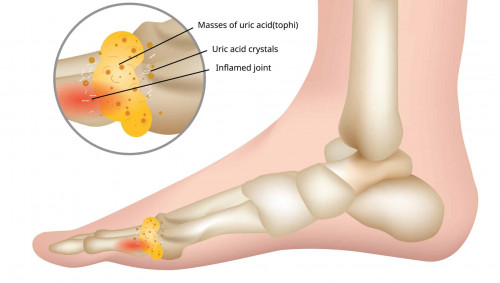Uric acid is a medical condition caused by the accumulation of uric acid crystals in the body, especially around the joints, which can cause pain and inflammation. While genetic factors can influence an individual's uric acid levels, an unhealthy diet is often a major cause of increased uric acid levels in the body. Therefore, adopting a healthy diet can be a crucial step in managing uric acid and maintaining optimal joint health.
Consuming Low-Purine Foods
Purines are compounds found in foods that can increase uric acid levels in the body. To reduce the risk of uric acid buildup, it is important to consume low-purine foods such as fruits, green vegetables, legumes, and whole grains. Avoid or limit the consumption of high-purine foods such as red meat, seafood (shrimp, sardines, shellfish), and processed foods.
2. Drinking Plenty of Water
Water helps dilute urine and increase the excretion of uric acid from the body. Drink at least 8 glasses of water a day to keep the body well hydrated. Consuming water can also help prevent the formation of uric acid crystals that cause joint pain.
3. Increasing Fiber in the Diet
Fiber, especially soluble fiber, can help reduce uric acid levels in the body by binding to it and excreting it from the body through feces. Fiber-rich foods include fruits, vegetables, legumes, and whole grains. Consuming a high-fiber diet can also help maintain a healthy weight, which is a key factor in reducing the risk of uric acid.
4. Avoiding Alcohol and Sugary Drinks
Alcohol, especially beer and other alcoholic beverages, can increase uric acid production in the body and inhibit its excretion. Avoid or limit alcohol consumption to reduce the risk of increased uric acid levels. Additionally, avoid sugary drinks high in fructose, such as sodas, as fructose can also increase uric acid production.
5. Limiting Consumption of Saturated Fat Foods
Foods high in saturated fats, such as fast food, processed foods, and high-fat dairy products, can increase uric acid levels in the body. Limit the consumption of foods containing saturated fats and choose healthy fat sources such as avocados, nuts, and olive oil.
6. Regularly Undergoing Uric Acid Examinations
This is important. This is done to ensure the uric acid levels in the blood, thus preventing hyperuricemia. For keeping track of uric acid levels, PT Isotekindo Intertama presents the UASure II Blood Uric Acid Monitoring System, a cutting-edge device utilizing advanced biosensor technology. It stands as the pioneering handheld system catering to both healthcare practitioners and individuals, offering portability and user-friendly operation for convenient self-monitoring of blood uric acid levels. This marks the evolution to the second generation of UA Sure products.
Here are the exciting features and benefits of the UASure II Blood Uric Acid Monitoring System:
- Ample Memory Capacity: With a large memory capacity of up to 200 memory entries, it allows for extensive data storage and tracking.
- Minimal Blood Sample: Requiring only a small blood sample (≧ 1.5 μL), it minimizes discomfort during the examination by eliminating the need for deep stabs.
- Swift Testing: The test process takes just 10 seconds, providing quick and efficient results for timely monitoring.
- Convenient Data Transfer: Equipped with a USB port, the UASure II Blood Uric Acid Monitoring System simplifies data transfer, ensuring ease of use.
Conclusion
Managing uric acid with a healthy diet is an important step in maintaining joint health and preventing complications associated with uric acid. By consuming low-purine foods, drinking plenty of water, increasing fiber in the diet, avoiding alcohol and sugary drinks, and limiting consumption of foods high in saturated fats, an individual can reduce the risk of increased uric acid levels in the body and improve overall health. Consult a doctor or nutritionist for advice tailored to individual health conditions.
References:
-
Choi, H.K., & Mount, D.B. (2009). Rationale and Methodology of Population-Based Study of Serum Uric Acid and Cardiovascular Disease: The Framingham Heart Study. In S. G. Younge & T. W. Chalem (Eds.), Uric Acid (pp. 21–38). Humana Press.
-
Juraschek, S.P., Miller, E.R., Gelber, A.C., et al. (2011). Effect of Oral Vitamin C Supplementation on Serum Uric Acid: A Meta-Analysis of Randomized Controlled Trials. Arthritis Care & Research, 63(9), 1295–1306.
-
Maiuolo, J., Oppedisano, F., Gratteri, S., et al. (2016). Regulation of Uric Acid Metabolism and Excretion. International Journal of Cardiology, 213, 8–14.
-
Zhu, Y., Pandya, B.J., Choi, H.K., et al. (2011). Prevalence of Gout and Hyperuricemia in the US General Population: The National Health and Nutrition Examination Survey 2007–2008. Arthritis & Rheumatism, 63(10), 3136–3141.






